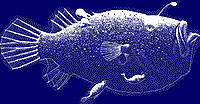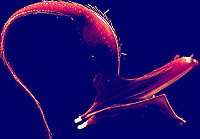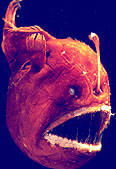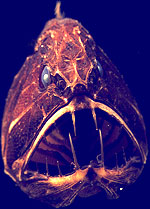
|

|

|
Deep-Sea Bestiary
by Peter Tyson
The ocean depths are home to a phantasmagoria of bizarre
creatures, ranging from the footballfish to the "vampire squid
from hell." Living in the dark at crushing depths, the animals
below are rarely seen by human beings. The photographs, which
are of deceased creatures brought up from the deep, were shot
by famed underwater photographer Norbert Wu. The drawings, by
celebrated marine artist Richard Ellis, appear in his book
Deep Atlantic: Life, Death, and Exploration in the Abyss
(Knopf, 1996). Click on any of the pictures below to see the
full view.


|
This comely female
anglerfish, Cryptopsaras couesi, has
attracted not one but two tiny parasitic males
(see drawing).
The males have permanently attached themselves to
her side to facilitate breeding (as is typical of
most anglerfish). Perhaps she has particularly
appealing caruncles, the three luminescent sacs just
forward of her dorsal fin, which lend her her common
name, "triplewart sea devil." Along with the
lightable lure above her eye, the caruncles may also
help entice prey to within striking distance of this
18-inch-long
fish.
|
Talk about all mouth.
Eurypharynx pelecanoides, known colloquially
as the "umbrellamouth gulper," throws wide
its loosely hinged jaws and balloons out its mouth
to engulf hapless fishes, which are deposited in the
pouchlike lower jaw (hence its common name, pelican
eel). Though a fearsome-looking creature, the
pelican eel is only two feet long, including the
whiplike tail. It lives in all the world's oceans at
depths exceeding 6,500 feet.
|


|

|
In this image, the
anglerfish Melanocetus johnsoni not only
looks like a basketball, it looks like it could
swallow one. Perhaps impressed by its rounded
aspect, the scientist describing this ball of a fish
even gave it a generic name that means "black
whale." Yet appearances can be deceiving. For all
its ferocious aspect, the "common black-devil," as
this species is known, reaches a maximum length of
five inches.
|
The viperfish, Chauliodus sloani, has such
lengthy lower fangs that they don't even fit in its
mouth, but rather project back dangerously close to
the eyes. No Chauliodus has ever been photographed
in its natural habitat, but a scientist who saw one
from the window of his bathyscaph off Portugal
reported that it hovered "head upwards, the long
axis of its body making an angle of about 45°
to the horizontal plane. The whiplike dorsal ray was
inclined forwards so that the tip dangled in front
of the mouth. Here, surely, is good circumstantial
evidence for deep-sea angling."
|

|

|
It's not hard to see why the common name of
Anoplogaster cornuta is
"fangtooth." (It has also been dubbed
"ogrefish.") In this species, juveniles
differ so strikingly from adults that it took 50
years for fish biologists to realize that
Anoplogaster and a genus they were calling
Caulolepsis were one and the same animal, just of
different ages. Fangtooths (or should we say
"fangteeth"?) are found in tropical and temperate
waters down to 16,000 feet.
|
Continue
The Mission |
Life in the Abyss |
The Last Frontier |
Dispatches
E-mail |
Resources |
Table of Contents
|
Abyss Home
Editor's Picks
|
Previous Sites
|
Join Us/E-mail
|
TV/Web Schedule
About NOVA |
Teachers |
Site Map |
Shop |
Jobs |
Search |
To print
PBS Online |
NOVA Online |
WGBH
©
| Updated October 2000
|
|
|









